
The Lost Crusade
- Thread starter Dunaden
- Start date
-
We have updated our Community Code of Conduct. Please read through the new rules for the forum that are an integral part of Paradox Interactive’s User Agreement.
You are using an out of date browser. It may not display this or other websites correctly.
You should upgrade or use an alternative browser.
You should upgrade or use an alternative browser.
A dynasty and the legacy of a Crusade, both made proud. May the epilogue do this grand tale justice.
Epilogue - Full Circle
In 1451, His Holiness Pope Leo XII , known as the Merry, intrigued by the rumors of possible Christian Kingdoms in the far east and perhaps looking for earthly fame to leave his mark in the world, announced a Crusade to free the Kingdom of Sindh from the Hindu barbarians of the Quzdarid Kingdom in India and bring the heathens of that land into Christ to save their immortal souls from Hell's eternal fires.
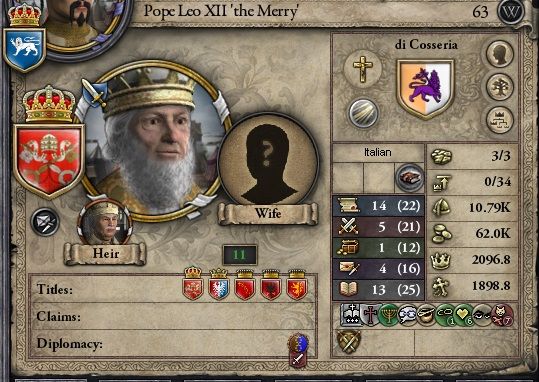
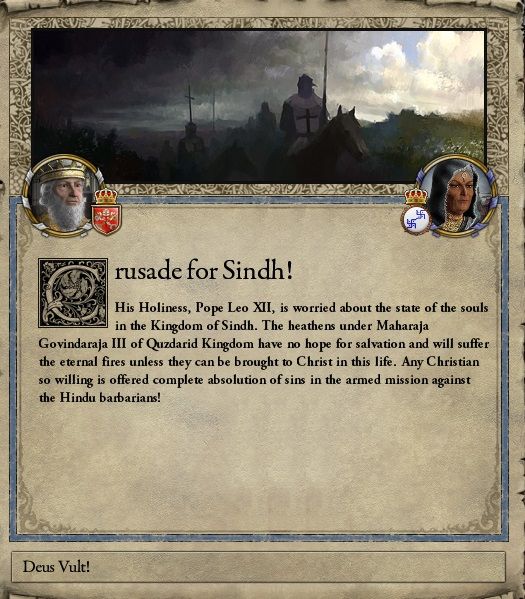
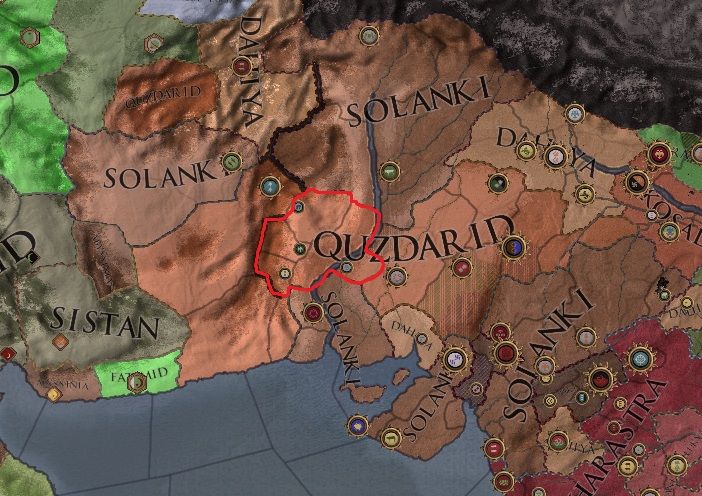
Christian rulers from all over Europe and even Africa answered his call, from mighty empires to lowly counts and knights.
The first to pledge support was Peter von Weimar who had succeeded a Laird as Emperor of the Holy Roman Empire.
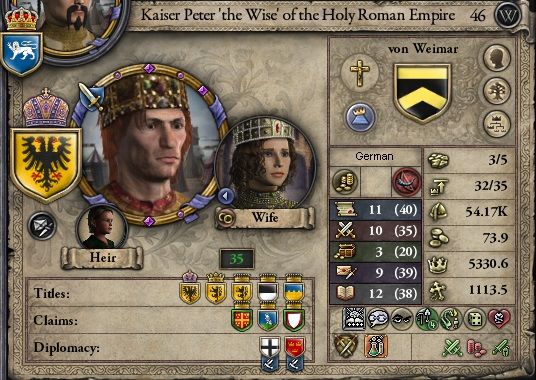
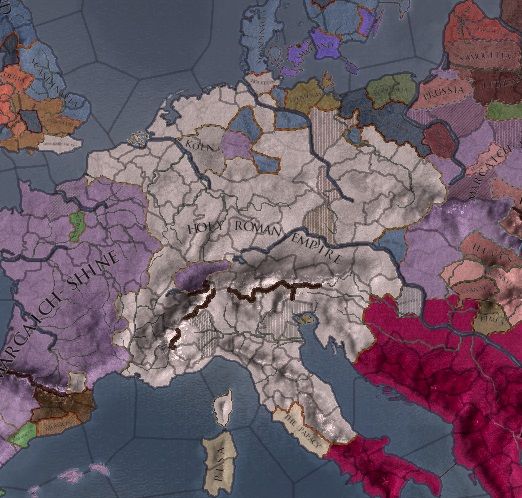
The von Weimar dynasty was becoming the most powerful in Christendom. The second Laird Byzantine Emperor had died childless, so the crown passed to his sister, Eilionoir Laird who was married to the brother of the current HRE Emperor. Their son Farquhar von Weimar was now the heir. The von Weimars would soon have two Empires within their grasp, where they had previously only ruled as the Earls of Vegl.
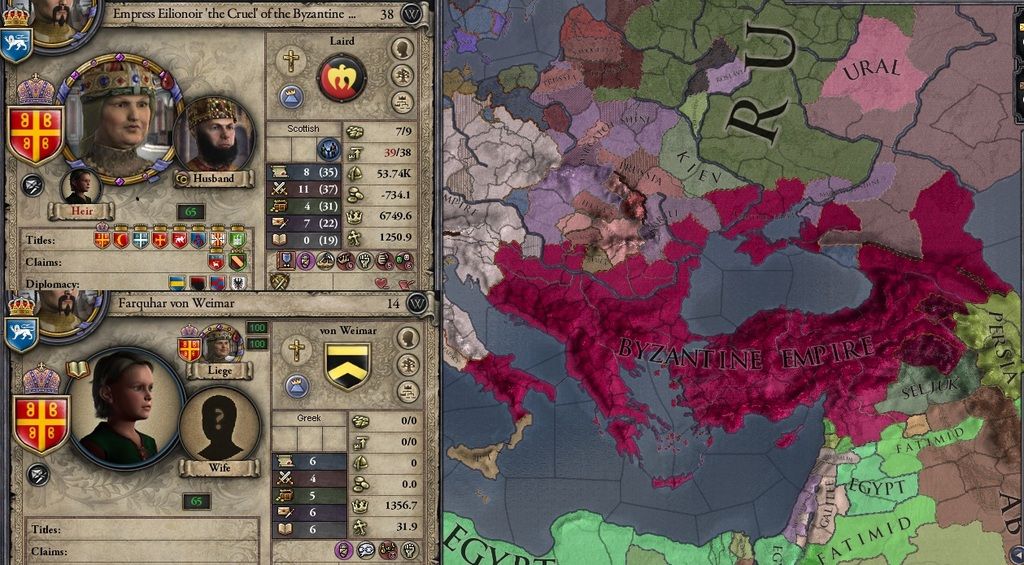
Emperor Gudleik Cerneu of the Scandinavian Empire also pledge his support for the Crusade, still making amends for his heretical grandfather, Torstein the Just, who had been the target of the Scottish Crusade that had freed Scotland from Scandinavian Empire 20 years earlier.
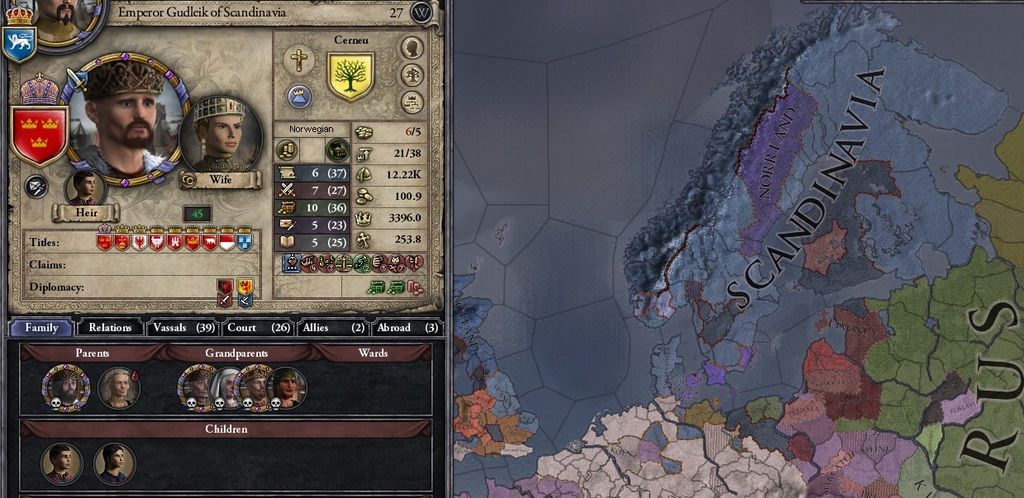
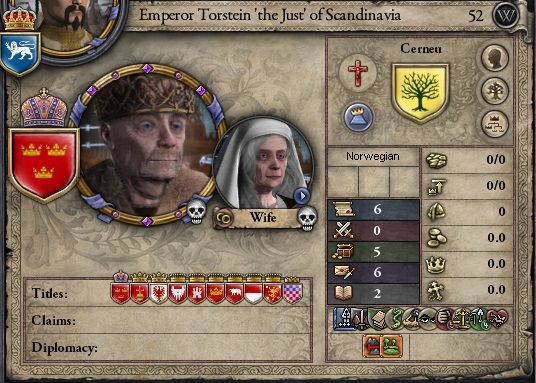
King Aulay the Apostle of Scotland would also join the new Crusade to repay the blood spilled by the last Crusaders for his Kingdom’s freedom.
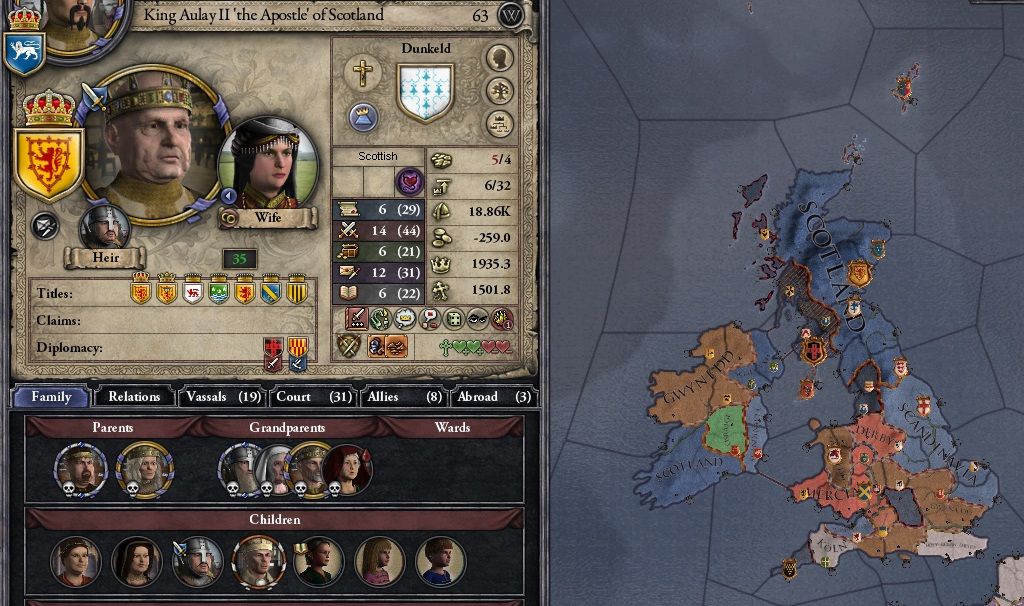
From the two Kerajid Kingdoms of Africa, both the Sultan It'ij of Kerajid and Sultana Tanebdatt of Egypt also joined the crusade. The Berber rulers were sending their desert warriors east.
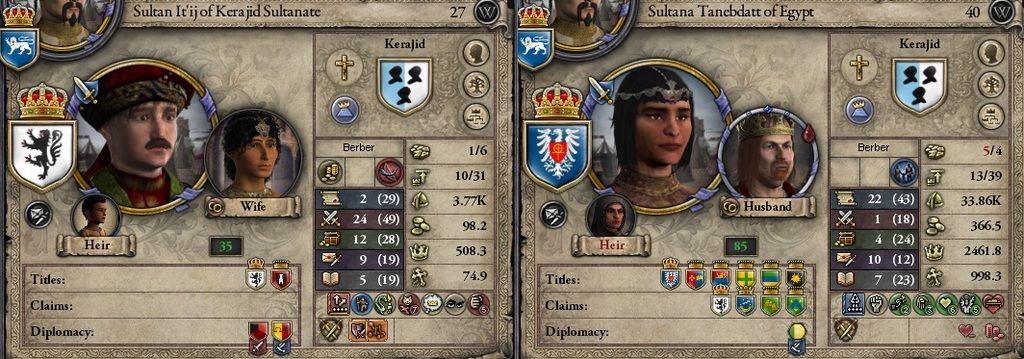

Out of the great Christian powers, only the Marcaich-Shine Empire ignored the Crusade. The Empire had just gone through troubled times. A war pressed for a cousin's claim had put James the Usurper on the Throne, but he had been just a drunken puppet to the Queen of Aquitaine. But on his death, his son Haimish had become the new Storm Rider Emperor and he had refused to be a puppet, so the Empire had been rocked by several revolts as different branches of the Laird dynasty vied for power. All the conflict had led to the Empire losing its grip on some of its territory including most of the Holy Land and some portions of the Iberian Peninsula. In the Holy Land they retain only the Duchy of Ascalon, the rest of the Kingdom of Jerusalem has broken up into several independent Catholic states. In Iberia, Seville and Murcia had also become independent.
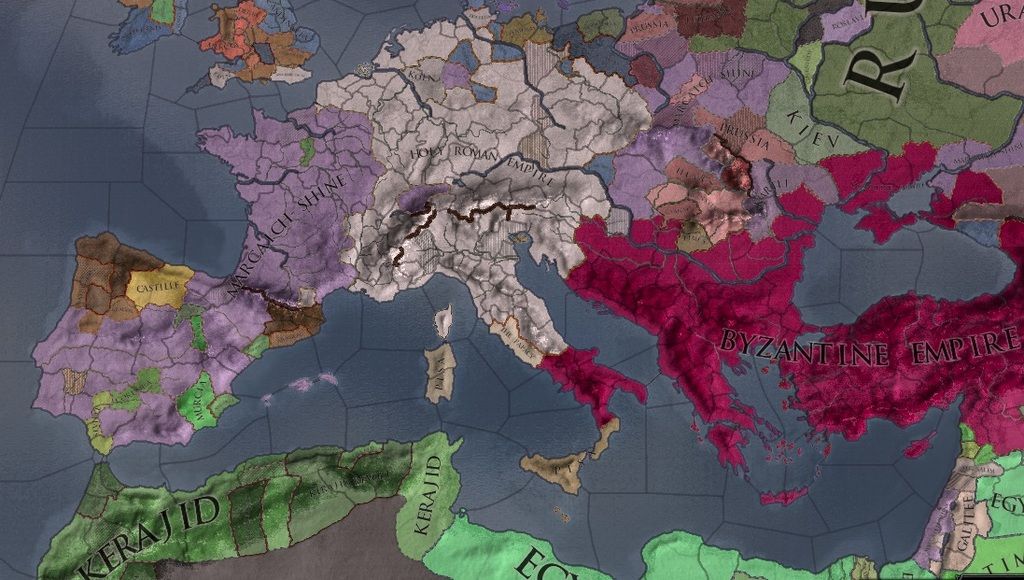
The civil wars had finally played out with the main branch of the Lairds restored to power in the form of 9 year-old boy, Maldred II.
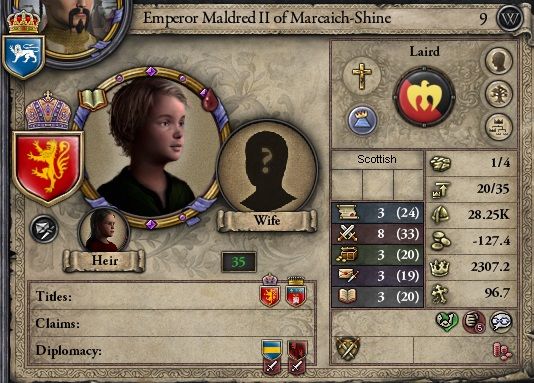
His regent had wisely decided now was not the time for the Empire to commit to sending the bulk of its strength half way around the world to support this Crusade, it would need to be prepared in case another pretender made an attempt at the throne.
****************************************************************************************************************
The Great Crusade met outside Jerusalem and headed east. They numbered over 100,000 with more stragglers following weeks or months behind. The Fatimids could do nothing to stop this giant army as it swept across their lands like a plague of locusts, they just scrambled to get out of its way. The Fatimids had recently had their own setbacks, losing the Arabia Peninsula to the Duqmids, though they still retained the Caliphate and Abyssinia.
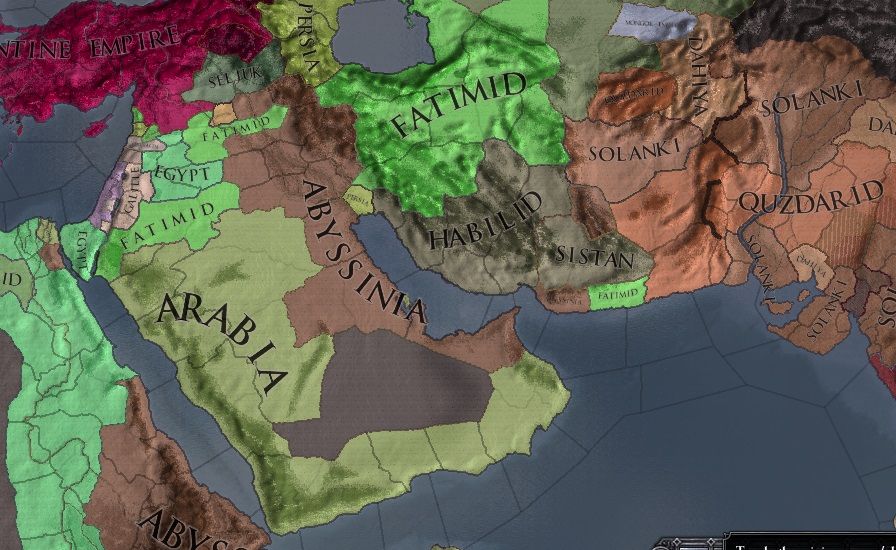
It would take close to two years for the Crusaders to gather and then cross the Middle East and the Hindu Kush and descend into the Indus Valley where the target of the Crusade, Sindh, lay.
The Crusaders found the western Quzdarid Kingdom already ravaged by war, empty villages and fields, burned towns, and bloody battlefields littered with broken weapons and bodies and picked over by scavengers. They met no resistance as they marched deeper into Sindh territory. Finally outside the city of Mastanj in the Sibi province, they came upon a large pavilion set by the road. A small mounted party left the pavilion and came toward the leaders of the army carrying a great white silk banned signaling their wish to parley. The party was led by a richly dressed man dressed in silks with a golden turban, obviously a great lord. He was followed by several soldiers who were richly armed and armored, obviously high ranking nobles and generals. The leader and his followers stopped about 20 feet away and dismounted and walked through the mud in the road toward the Pope and his party.
The golden turban gave a short bow to the party and asked a question, Leo looked to his interpreter.
“He asks if you are the Great Father of the Christians.”
The Pope looked back at the turbaned man and nodded.
The lord sighed, almost with relief, and turned and held out his hand to one of his followers. The soldier hesitated with a scowl, and then reluctantly handed the leader a jeweled tulwar, in a matching scabbard. The knights behind the Pope tensed and reached for their own weapons, but before any sword was drawn, the lord took a few more steps forward and knelt in the mud in front of the Pope’s horse, extending the tulwar hilt first, and began talking.
The Pope turned to his interpreter to find him staring at the lord in shock with his jaw hanging open.
“Who is he? What is he saying?”
The lord had stopped speaking when the Pope asked his question and also turned to look at the interpreter.
The interpreter shook himself and turned to the Pope. “Your Holiness, this man says he is Govindaraja Quzdarid, the Maharajah of the Quzdarid Kingdom, and he wishes to surrender to you and end the bloodshed and war between your people and his. He declares all the land of the Sindh is now yours to do with as you will.”
“He begs you to call off the White Tiger and let there be peace.”
The Pope after a moment’s hesitation dismounted and took the tulwar from the Maharajah’s hand.
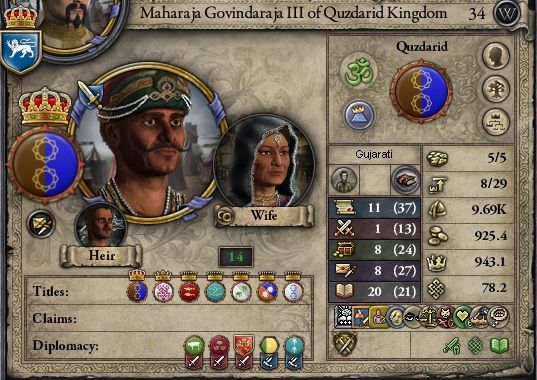
Hours later, after appropriating the Quzdarid pavilion and questioning the Maharajah further about the reasons for his unexpected surrender, Pope Leo and the other leaders of the Crusade were still confused about what had happened.
The most they got through the interpreter was that an army claiming to be part of a Christian Holy War had attacked Quzdarid over a year ago and had occupied most of the territory of the Kingdom of Sindh within Quzdarid. They were called Oriyans and their leader was known as the White Tiger by the Quzdarid. They had defeated the Maharajah’s armies and sacked his cities. The Maharajah had been willing to surrender months ago, but the leader of this army, insisted he did not have the authority to end the war, as only the Great Father of the Christians who had called for the war could end it. The Tiger had suggested the Maharajah look to the west for the Great Father’s coming.
The only other information they could decipher was that the White Tiger and his army were currently just to the east in Rajanpur.
Count Kuntuvdi Nakonid of Holstein, had joined the Pope and other leaders of Crusade as they had headed east with a small contingent of the army to Rajanpur to track down this WhiteTiger. Kuntuvdi was able to attach himself to the party as he was an independent ruler, not someone’s vassal. Holstein had somehow maintained its independence for over a 100 years, even though it sat on the border between the HRE and the Scandinavian Empires. Both Empires laid claim to the lone county, but neither Empire was willing to seize the lone county and spark a war with the other Empire, assuring Holstein’s continuing independence, but limiting its growth beyond its present borders.
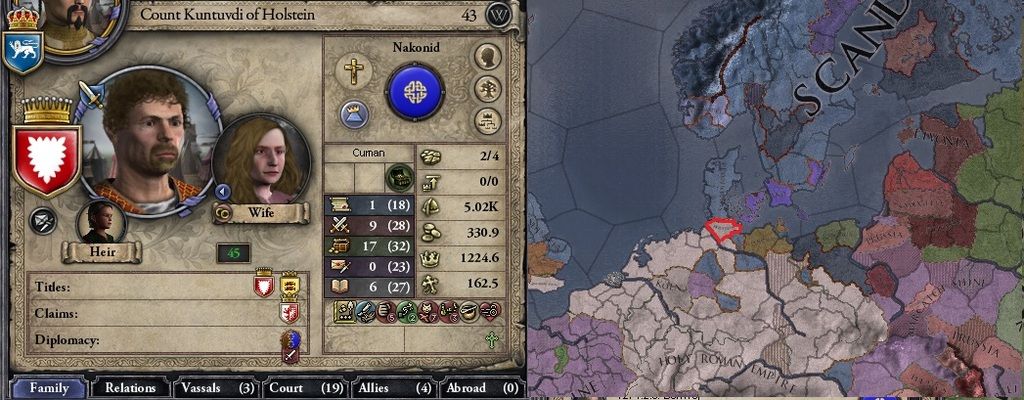
Count Kuntuvdi was alone among the Crusaders in that he had not come for riches or glory, he had come to find answers. His grandfather’s brother, an earlier Count of Holstein named Aepak, had come east over a hundred years ago, taking with him most of Holsteins’ nobility and soldiers. An entire generation had marched east never to be heard from again. It had taken Holstein years to recover from this loss. Kuntuvdi had not made the same mistake and had only brought a handful of retainers, Holstein would not pay just to satisfy his curiosity.
Outside the fortress at Rajanpur the Pope’s delegation was met by a strange party. The strangers were led by a small native man dressed in what appeared to be Bishop's robes, but made of bright silks rather than somber wool. The man introduced himself as Bishop Dharmarstha of Viraja in oddly accented Scottish. He first prostrated himself before Pope Leo XII and with tears of joy in his eyes kissed the papal ring. Then he begged the Pope, the two Emperors, and other leaders of the Crusade to accept his lord's invitation and hospitality in the city below. They were skeptical and first, but the odd little Bishop insisted, the city had been taken in the Pope's name and as part of the Crusade so it was his to dispose of.
Scouts were sent in closer to the city and were able to return unmolested. They reported the city showed signs of recent heavy fighting. The main gates were burned and broken and could not be shut if the main Crusader Army wanted to come in after the Pope.
In the end, the Pope agreed to enter the city with a heavily armed guard. So Pope Leo XII, Emperor Peter, Emperor Gudliek, King Aulay and dozens of other nobles and retainers, including the Count of Holstein, entered Rajanpur with an honor guard of almost 200 heavily armed knights. As they entered past the broken gates and fire blackened walls they were greeted by cheers. Foreign soldiers wearing an odd mix of armor and weapons, some familiar and some not, lined the main road, cheering the Pope as he made his way through the city. Most of the common soldiers appeared to be natives, with some lighter toned faces mixed in. They all wore badges depicting a white tiger on a blue field.
Bishop Dharmarstha lead the party further into the city until they came to the main keep. It also showed scars of recent fighting, with fresh axe cuts in the doors, burned outbuildings and patches of dried blood still present in the streets and courtyards. The party dismounted and marched into the great hall of the keep. The hall also showed signs of fighting and looting. Lighter spots on the walls showed where banners and trophies had been stripped away. The only banner present was at the far end of the hall, where a great blue and white silk banner bearing the sigil of a white tiger had been unevenly displayed.

Beneath this great banner, a young man sat on a raised throne. Several dozen soldiers and courtiers stood before him, but whatever conversation had been going on ended with the Pope's arrival, as they all turned as he made his entrance, and then dropped to their knees.
Pope Leo XII and his entourage began walking forward. Bishop Dharmarstha rushed to stand by the young man, and announced in his accented Scottish, "Your Holiness, may I present His Majesty, King Tadhg of Orissa, second of his name, Duke of Tosalia and Daksina Kosala, Champion of the Faith, Prince of the Marcaich-Shine, and son of Clan Laird.
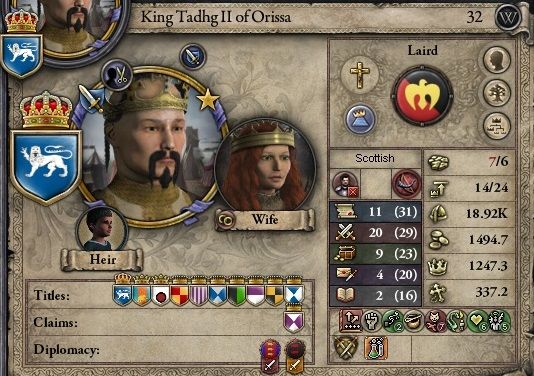
The young King came forward and knelt in front of Pope Leo IX and kissed the stunned Pope's ring.
Out of the entire contingent of Crusaders with Pope Leo the Merry, only Count Kuntuvdi understood the significance of this King’s titles. The Emperors and other lords were questioning how they thought Marcaich-Shine had not joined the Crusade, or how had the Storm Riders beat them to India. The Count had not recognized the earlier term “Oriyan” describing the army that had beaten the Quzdarid and its connection to the answers he sought, but when he heard “Orissa” he knew right away. He pushed his way to the front of the delegation.
“The Crusade for Orissa! You are from the Seventh Crusade.”
The Orissan King turned toward him and smiled, “Yes, we are the descendants of the Seventh Crusade that claimed the Kingdom of Orissa for God.”
Turning back to Pope Leo the Merry, King Tadhg said. "Welcome, Your Holiness, to fabled Hindustan!"
In 1451, His Holiness Pope Leo XII , known as the Merry, intrigued by the rumors of possible Christian Kingdoms in the far east and perhaps looking for earthly fame to leave his mark in the world, announced a Crusade to free the Kingdom of Sindh from the Hindu barbarians of the Quzdarid Kingdom in India and bring the heathens of that land into Christ to save their immortal souls from Hell's eternal fires.



Christian rulers from all over Europe and even Africa answered his call, from mighty empires to lowly counts and knights.
The first to pledge support was Peter von Weimar who had succeeded a Laird as Emperor of the Holy Roman Empire.


The von Weimar dynasty was becoming the most powerful in Christendom. The second Laird Byzantine Emperor had died childless, so the crown passed to his sister, Eilionoir Laird who was married to the brother of the current HRE Emperor. Their son Farquhar von Weimar was now the heir. The von Weimars would soon have two Empires within their grasp, where they had previously only ruled as the Earls of Vegl.

Emperor Gudleik Cerneu of the Scandinavian Empire also pledge his support for the Crusade, still making amends for his heretical grandfather, Torstein the Just, who had been the target of the Scottish Crusade that had freed Scotland from Scandinavian Empire 20 years earlier.


King Aulay the Apostle of Scotland would also join the new Crusade to repay the blood spilled by the last Crusaders for his Kingdom’s freedom.

From the two Kerajid Kingdoms of Africa, both the Sultan It'ij of Kerajid and Sultana Tanebdatt of Egypt also joined the crusade. The Berber rulers were sending their desert warriors east.


Out of the great Christian powers, only the Marcaich-Shine Empire ignored the Crusade. The Empire had just gone through troubled times. A war pressed for a cousin's claim had put James the Usurper on the Throne, but he had been just a drunken puppet to the Queen of Aquitaine. But on his death, his son Haimish had become the new Storm Rider Emperor and he had refused to be a puppet, so the Empire had been rocked by several revolts as different branches of the Laird dynasty vied for power. All the conflict had led to the Empire losing its grip on some of its territory including most of the Holy Land and some portions of the Iberian Peninsula. In the Holy Land they retain only the Duchy of Ascalon, the rest of the Kingdom of Jerusalem has broken up into several independent Catholic states. In Iberia, Seville and Murcia had also become independent.

The civil wars had finally played out with the main branch of the Lairds restored to power in the form of 9 year-old boy, Maldred II.

His regent had wisely decided now was not the time for the Empire to commit to sending the bulk of its strength half way around the world to support this Crusade, it would need to be prepared in case another pretender made an attempt at the throne.
****************************************************************************************************************
The Great Crusade met outside Jerusalem and headed east. They numbered over 100,000 with more stragglers following weeks or months behind. The Fatimids could do nothing to stop this giant army as it swept across their lands like a plague of locusts, they just scrambled to get out of its way. The Fatimids had recently had their own setbacks, losing the Arabia Peninsula to the Duqmids, though they still retained the Caliphate and Abyssinia.

It would take close to two years for the Crusaders to gather and then cross the Middle East and the Hindu Kush and descend into the Indus Valley where the target of the Crusade, Sindh, lay.
The Crusaders found the western Quzdarid Kingdom already ravaged by war, empty villages and fields, burned towns, and bloody battlefields littered with broken weapons and bodies and picked over by scavengers. They met no resistance as they marched deeper into Sindh territory. Finally outside the city of Mastanj in the Sibi province, they came upon a large pavilion set by the road. A small mounted party left the pavilion and came toward the leaders of the army carrying a great white silk banned signaling their wish to parley. The party was led by a richly dressed man dressed in silks with a golden turban, obviously a great lord. He was followed by several soldiers who were richly armed and armored, obviously high ranking nobles and generals. The leader and his followers stopped about 20 feet away and dismounted and walked through the mud in the road toward the Pope and his party.
The golden turban gave a short bow to the party and asked a question, Leo looked to his interpreter.
“He asks if you are the Great Father of the Christians.”
The Pope looked back at the turbaned man and nodded.
The lord sighed, almost with relief, and turned and held out his hand to one of his followers. The soldier hesitated with a scowl, and then reluctantly handed the leader a jeweled tulwar, in a matching scabbard. The knights behind the Pope tensed and reached for their own weapons, but before any sword was drawn, the lord took a few more steps forward and knelt in the mud in front of the Pope’s horse, extending the tulwar hilt first, and began talking.
The Pope turned to his interpreter to find him staring at the lord in shock with his jaw hanging open.
“Who is he? What is he saying?”
The lord had stopped speaking when the Pope asked his question and also turned to look at the interpreter.
The interpreter shook himself and turned to the Pope. “Your Holiness, this man says he is Govindaraja Quzdarid, the Maharajah of the Quzdarid Kingdom, and he wishes to surrender to you and end the bloodshed and war between your people and his. He declares all the land of the Sindh is now yours to do with as you will.”
“He begs you to call off the White Tiger and let there be peace.”
The Pope after a moment’s hesitation dismounted and took the tulwar from the Maharajah’s hand.

Hours later, after appropriating the Quzdarid pavilion and questioning the Maharajah further about the reasons for his unexpected surrender, Pope Leo and the other leaders of the Crusade were still confused about what had happened.
The most they got through the interpreter was that an army claiming to be part of a Christian Holy War had attacked Quzdarid over a year ago and had occupied most of the territory of the Kingdom of Sindh within Quzdarid. They were called Oriyans and their leader was known as the White Tiger by the Quzdarid. They had defeated the Maharajah’s armies and sacked his cities. The Maharajah had been willing to surrender months ago, but the leader of this army, insisted he did not have the authority to end the war, as only the Great Father of the Christians who had called for the war could end it. The Tiger had suggested the Maharajah look to the west for the Great Father’s coming.
The only other information they could decipher was that the White Tiger and his army were currently just to the east in Rajanpur.
Count Kuntuvdi Nakonid of Holstein, had joined the Pope and other leaders of Crusade as they had headed east with a small contingent of the army to Rajanpur to track down this WhiteTiger. Kuntuvdi was able to attach himself to the party as he was an independent ruler, not someone’s vassal. Holstein had somehow maintained its independence for over a 100 years, even though it sat on the border between the HRE and the Scandinavian Empires. Both Empires laid claim to the lone county, but neither Empire was willing to seize the lone county and spark a war with the other Empire, assuring Holstein’s continuing independence, but limiting its growth beyond its present borders.

Count Kuntuvdi was alone among the Crusaders in that he had not come for riches or glory, he had come to find answers. His grandfather’s brother, an earlier Count of Holstein named Aepak, had come east over a hundred years ago, taking with him most of Holsteins’ nobility and soldiers. An entire generation had marched east never to be heard from again. It had taken Holstein years to recover from this loss. Kuntuvdi had not made the same mistake and had only brought a handful of retainers, Holstein would not pay just to satisfy his curiosity.
Outside the fortress at Rajanpur the Pope’s delegation was met by a strange party. The strangers were led by a small native man dressed in what appeared to be Bishop's robes, but made of bright silks rather than somber wool. The man introduced himself as Bishop Dharmarstha of Viraja in oddly accented Scottish. He first prostrated himself before Pope Leo XII and with tears of joy in his eyes kissed the papal ring. Then he begged the Pope, the two Emperors, and other leaders of the Crusade to accept his lord's invitation and hospitality in the city below. They were skeptical and first, but the odd little Bishop insisted, the city had been taken in the Pope's name and as part of the Crusade so it was his to dispose of.
Scouts were sent in closer to the city and were able to return unmolested. They reported the city showed signs of recent heavy fighting. The main gates were burned and broken and could not be shut if the main Crusader Army wanted to come in after the Pope.
In the end, the Pope agreed to enter the city with a heavily armed guard. So Pope Leo XII, Emperor Peter, Emperor Gudliek, King Aulay and dozens of other nobles and retainers, including the Count of Holstein, entered Rajanpur with an honor guard of almost 200 heavily armed knights. As they entered past the broken gates and fire blackened walls they were greeted by cheers. Foreign soldiers wearing an odd mix of armor and weapons, some familiar and some not, lined the main road, cheering the Pope as he made his way through the city. Most of the common soldiers appeared to be natives, with some lighter toned faces mixed in. They all wore badges depicting a white tiger on a blue field.
Bishop Dharmarstha lead the party further into the city until they came to the main keep. It also showed scars of recent fighting, with fresh axe cuts in the doors, burned outbuildings and patches of dried blood still present in the streets and courtyards. The party dismounted and marched into the great hall of the keep. The hall also showed signs of fighting and looting. Lighter spots on the walls showed where banners and trophies had been stripped away. The only banner present was at the far end of the hall, where a great blue and white silk banner bearing the sigil of a white tiger had been unevenly displayed.

Beneath this great banner, a young man sat on a raised throne. Several dozen soldiers and courtiers stood before him, but whatever conversation had been going on ended with the Pope's arrival, as they all turned as he made his entrance, and then dropped to their knees.
Pope Leo XII and his entourage began walking forward. Bishop Dharmarstha rushed to stand by the young man, and announced in his accented Scottish, "Your Holiness, may I present His Majesty, King Tadhg of Orissa, second of his name, Duke of Tosalia and Daksina Kosala, Champion of the Faith, Prince of the Marcaich-Shine, and son of Clan Laird.

The young King came forward and knelt in front of Pope Leo IX and kissed the stunned Pope's ring.
Out of the entire contingent of Crusaders with Pope Leo the Merry, only Count Kuntuvdi understood the significance of this King’s titles. The Emperors and other lords were questioning how they thought Marcaich-Shine had not joined the Crusade, or how had the Storm Riders beat them to India. The Count had not recognized the earlier term “Oriyan” describing the army that had beaten the Quzdarid and its connection to the answers he sought, but when he heard “Orissa” he knew right away. He pushed his way to the front of the delegation.
“The Crusade for Orissa! You are from the Seventh Crusade.”
The Orissan King turned toward him and smiled, “Yes, we are the descendants of the Seventh Crusade that claimed the Kingdom of Orissa for God.”
Turning back to Pope Leo the Merry, King Tadhg said. "Welcome, Your Holiness, to fabled Hindustan!"
- 3
- 1
A brilliant epilogue for an amazing story. I like apparently any area on the map would have made for a fun story, my personal favorites being Egypt and Holstein. The Pope must feel like the luckiest man in the world, a victorious Crusade all but handed to him on a silver platter by the descendants of a forgotten success.
Well done! Should you start another AAR, I'll absolutely follow it.
Well done! Should you start another AAR, I'll absolutely follow it.
The Laird grip on Europe falters but one branch of the family has just been reunited with Christendom. Excellent stuff!
Full circle indeed, It's quite awesome that this kingdom of God is now reunited with the rest of Christendom  , If you ever decide to play this save to EU4, Consider me subbed! I'd love to see the knights of Orissa completing St.Thomas' dream of an India united in faith.
, If you ever decide to play this save to EU4, Consider me subbed! I'd love to see the knights of Orissa completing St.Thomas' dream of an India united in faith.
- 2
Wow, what a great epilogue!
Thank You.
A brilliant epilogue for an amazing story. I like apparently any area on the map would have made for a fun story, my personal favorites being Egypt and Holstein. The Pope must feel like the luckiest man in the world, a victorious Crusade all but handed to him on a silver platter by the descendants of a forgotten success.
Well done! Should you start another AAR, I'll absolutely follow it.
Thanks, the world definitely took some odd turns, with Aztec Catholics living in Africa, Cuman Emperors in England, and the story of Keraja the Liberator. I didn't have time to actually fight the Crusade as it was declared within the last couple years of game time, so I took some liberties for the story because a second Crusade to India was too perfect to reintroduce Orissa tot he world.
I have a couple ideas for AARs, just trying decide which one I want to run with. Coming soon.
The Laird grip on Europe falters but one branch of the family has just been reunited with Christendom. Excellent stuff!
Thanks, The young Laird Emperor Maldred II looks promising, if he can survive to adulthood, so wouldn't count them out.
Full circle indeed, It's quite awesome that this kingdom of God is now reunited with the rest of Christendom, If you ever decide to play this save to EU4, Consider me subbed! I'd love to see the knights of Orissa completing St.Thomas' dream of an India united in faith.
I will probably transfer it to EUIV and mess around, but EUIV hasn't grabbed me enough to commit to playing through and writing an AAR. I'll stick with CK2 for now, or possibly Stellaris.
Again, thanks to all who commented and to all who read it. I'm glad you all enjoyed, it was fun to write and I will definitely being doing another AAR.
- 3
A follow up on the Scotto-Indic Galactic Empire? I'd read that.I'll stick with CK2 for now, or possibly Stellaris.
What makes you think it's a Indo-Scot galactic empire? For all we know Earth could have launched a space crusade, where the Indo-Scot ships got lost and he's playing as the lost crusaders again...only in space.A follow up on the Scotto-Indic Galactic Empire? I'd read that.

